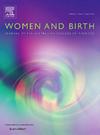Student midwives’ exposure to physiological birth practices: A cross-sectional study of 3055 births during 2020–23 in England
IF 4.1
2区 医学
Q1 NURSING
引用次数: 0
Abstract
Background
Among a range of care episodes and proficiencies UK midwifery students must complete to qualify, they need to personally facilitate 40 births. Students’ experiences of midwifery-led birth practices are dependent on their exposure within the clinical environment; however, such variation has not yet been explored.
Aim
The aim of this study was to analyse, describe and compare the characteristics of the 40 births personally facilitated by one cohort of 77 students within one English inner-city university.
Methods
Routinely collected data were extracted from 77 undergraduate student midwifery documents relating to births from 2020 to 2023. 3055 births were included. Data were analysed using descriptive and inferential statistics.
Findings
Most births occurred in Obstetric Unit (OU) settings (71 %). Most care was provided to birthing women/people who were multiparous at term gestation, who used at least one form of pharmacological analgesia. Most births were facilitated in either semi recumbent (45.6 %) or lithotomy birth positions (24 %) with the OU setting accounting for 91 % of these. Some birthing pool use for labour and/or birth were documented where the majority occurred in Alongside Midwifery Unit (AMU) settings. Comparisons between each student demonstrated wide variations of exposure to midwifery-led care practices.
Conclusion
Our findings highlighted that the students had extensive experience within OUs and with medicalised care practices but less consistent exposure to midwifery-led practices. Without exposure to midwifery-led birth practices across all settings, students qualify without the necessary experience to build their competency to optimise physiological birth processes, raising concerns for their preceptor period and beyond.
学生助产士接触生理分娩实践:一项对英格兰2020-23年3055例分娩的横断面研究
在一系列护理情节和熟练程度中,英国助产学学生必须完成才能获得资格,他们需要亲自协助40次分娩。学生的助产士主导的分娩实践经验取决于他们在临床环境中的暴露;然而,这种变化尚未被探索。目的本研究的目的是分析、描述和比较由一所英国市中心大学的77名学生组成的队列亲自促成的40名新生儿的特征。方法从2020年至2023年77名本科生助产资料中提取常规收集的数据。共纳入3055名新生儿。数据分析采用描述性和推断性统计。大多数分娩发生在产科(OU)环境中(71% %)。大多数护理是提供给分娩妇女/人谁是多胎足月妊娠,谁使用至少一种形式的药物镇痛。大多数分娩是半卧位(45.6% %)或取石位(24% %),其中OU位占91% %。记录了一些分娩池用于分娩和/或分娩的情况,其中大多数发生在辅助助产单位(AMU)设置。每个学生之间的比较表明,接触助产士领导的护理实践的差异很大。结论:我们的研究结果强调,学生在ou和医疗护理实践中有丰富的经验,但较少持续接触助产士主导的实践。如果没有在所有环境中接触助产士主导的分娩实践,学生就没有必要的经验来建立他们优化生理分娩过程的能力,这引起了他们对导师期及以后的担忧。
本文章由计算机程序翻译,如有差异,请以英文原文为准。
求助全文
约1分钟内获得全文
求助全文
来源期刊

Women and Birth
NURSING-OBSTETRICS & GYNECOLOGY
CiteScore
7.20
自引率
13.20%
发文量
371
审稿时长
27 days
期刊介绍:
Women and Birth is the official journal of the Australian College of Midwives (ACM). It is a midwifery journal that publishes on all matters that affect women and birth, from pre-conceptual counselling, through pregnancy, birth, and the first six weeks postnatal. All papers accepted will draw from and contribute to the relevant contemporary research, policy and/or theoretical literature. We seek research papers, quality assurances papers (with ethical approval) discussion papers, clinical practice papers, case studies and original literature reviews.
Our women-centred focus is inclusive of the family, fetus and newborn, both well and sick, and covers both healthy and complex pregnancies and births. The journal seeks papers that take a woman-centred focus on maternity services, epidemiology, primary health care, reproductive psycho/physiology, midwifery practice, theory, research, education, management and leadership. We also seek relevant papers on maternal mental health and neonatal well-being, natural and complementary therapies, local, national and international policy, management, politics, economics and societal and cultural issues as they affect childbearing women and their families. Topics may include, where appropriate, neonatal care, child and family health, women’s health, related to pregnancy, birth and the postpartum, including lactation. Interprofessional papers relevant to midwifery are welcome. Articles are double blind peer-reviewed, primarily by experts in the field of the submitted work.
 求助内容:
求助内容: 应助结果提醒方式:
应助结果提醒方式:


